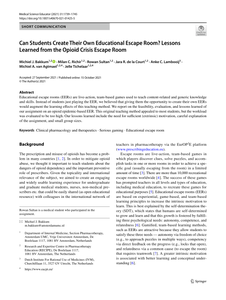Dit Trendrapport Open Educational Resources 2013 beschrijft de trends op het gebied van open educational resources (OER) en open onderwijs in binnen- en buitenland, geschreven vanuit de context van het Nederlandse hoger onderwijs. Dat gebeurt aan de hand van vijftien artikelen van Nederlandse experts op het gebied van open en online onderwijs. Ook bevat het vijftien korte intermezzo’s met spraakmakende voorbeelden.
DOCUMENT

Dit rapport beschrijft de trends in binnen- en buitenland op het gebied van Open Educational Resources. Dat gebeurt aan de hand van twaalf artikelen van Nederlandse experts op het gebied van open leermaterialen in het hoger onderwijs. Ook bevat het rapport twaalf intermezzo’s met spraakmakende voorbeelden.
DOCUMENT

In de afgelopen jaren is de belangstelling voor gebruik van open leermaterialen en open online cursussen sterk gegroeid. Met name de Massive Open Online Courses (MOOC’s) hebben deze belangstelling aangewakkerd. Medio 2015 heeft minister Bussemaker in haar strategische agenda “HO2025, de waarde(n) van weten” als ambities uitgesproken dat in 2025 alle docenten in het hoger onderwijs hun leermaterialen delen en dat instellingen elkaars MOOC’s gaan erkennen. Om deze ambities realiteit te maken zal nog veel werk verricht moeten worden, zowel door instellingen als door de overheid en instellingsoverstijgende organisaties als SURF. Om beter te kunnen bepalen welke activiteiten daarvoor moeten worden gestart is een beeld van de huidige stand van zaken rondom publiceren en gebruik van zowel Open Educational Resources (OER) als MOOC’s nuttig. Deze survey is bedoeld om inzicht krijgen in de stand van zaken rond gebruik en hergebruik van Open Educational Resources en MOOC´s bij bekostigde hogeronderwijsinstellingen in Nederland.
DOCUMENT

Digital educational escape rooms (DEERs) can provide an engaging gamified learning experience for students that is easy to use and sustainable for teachers. Though well-established in the STEM fields, where escape rooms often call for students to apply procedural skills, escape rooms are also used across a range of subjects to impact durable skills and attitudes such as communication, collaboration, and critical thinking. This paper seeks to extend the application of DEERs into social entrepreneurship (SE) education by exploring the DEER design elements relevant to the SE field. This paper will focus on developing durable skills and attitudes associated with social entrepreneurship, an area of entrepreneurship that seeks to create businesses with positive social impact. To identify the relevant design elements in DEERs, we conducted a systematic literature review. The research question was "Which design elements of digital educational escape rooms are necessary to teach social entrepreneurship skills and competencies?” This current paper builds on this type of framework by highlighting the relationship between the components of a DEER and learning objectives, specifically those relevant to a social entrepreneur’s educational context. For example, almost all papers reported successful collaboration in online groups. The authors also found that specific puzzle types were less important than the gamified context on impact on learning and skill development. Thus, the authors contribute to our understanding of how DEERs can relate to SE specific learning objectives, skills, and attitudes.
DOCUMENT
Wessels asks the question what kind of educational space we should open in response to complex questions and challenges that permeate our contemporary, shared world (e.g., related to climate change and multiculturalism).
DOCUMENT
Let's Get Personal - Social Personalization for Sustainable Long-Term Educational Robots
DOCUMENT
How to open up spaces to make education more meaningful? The concept of space can involve educational interactions, relationships, contents and other relevant aspects relating to this purpose. The book presents three perspectives to engage in opening up spaces. It empowers pupils, students, and teachers to develop as unique individuals, better relate to the communities and cultural traditions to which they belong, and to develop new visions, understandings, and ways of living.This volume is the result of the search of a number of educational professionals on how to open up spaces to make education more meaningful. The opened spaces involve educational interactions, relationships, contents and other relevant aspects relating to this purpose.
DOCUMENT
Abstract Educational escape rooms (EERs) are live-action, team-based games used to teach content-related and generic knowledge and skills. Instead of students just playing the EER, we believed that giving them the opportunity to create their own EERs would augment the learning efects of this teaching method. We report on the feasibility, evaluation, and lessons learned of our assignment on an opioid epidemic-based EER. This original teaching method appealed to most students, but the workload was evaluated to be too high. Our lessons learned include the need for sufcient (extrinsic) motivation, careful explanation of the assignment, and small group sizes.
MULTIFILE

How lecturers in higher education handle, or curate, educational resources during course design, has become increasingly important with the growing amount of digitally available educational materials. Despite the recognition of curation in educational literature and the development of two conceptual models, there is a lack of empirical knowledge of lecturers' actual curational practices. Through 23 semi-structured interviews at a Dutch University of Applied Sciences, this study identified six categories of distinguishable but interconnected activities that constitute lecturers' curational behaviour, taking place within the context of course design. These activities are: searching for resources, assessing and selecting resources, creating and editing resources, structuring resources, sharing resources, and soliciting feedback. The findings suggest that lecturers underemphasize the construction of a narrative that relates the resources and are providing students with little didactical support when sharing the resources. This paper offers an empirical a foundation for educational curation and suggests directions for future research to inform lecturers’ course design practices and enhance support for lecturers in this critical task.
DOCUMENT

This report is the result of a study commissioned by UNESCO-UNEVOC to fill the gap both on mapping the landscape of the use of Open Educational Resources (OER) and open practices in the field of Technical and Vocational Education and Training (TVET) and to provide Member States and UNESCO, in particular UNESCO-UNEVOC, with recommendations to support the creation and the use of OER in TVET.
LINK